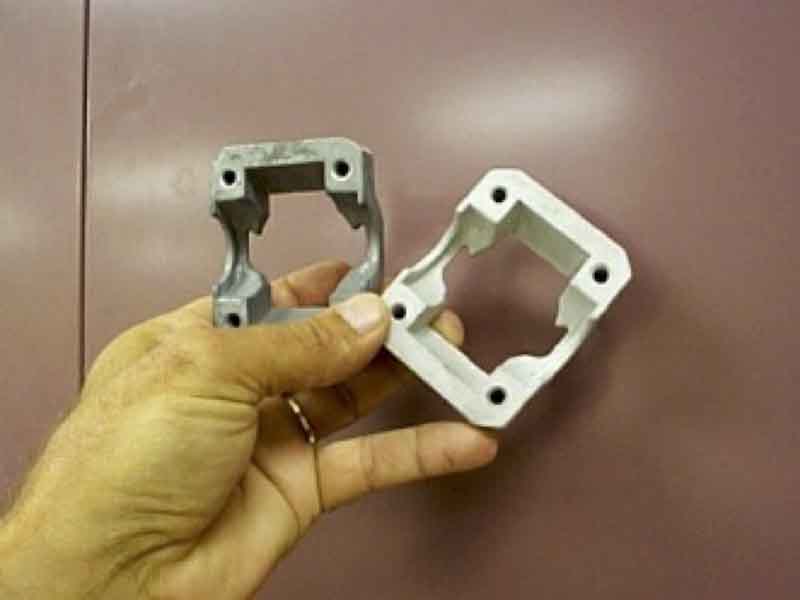The primary use of a deox is to clean the residue (smut) off of an etched aluminum part. Etch smut is made up of the chemical compounds that are found in different aluminum alloys.
These compounds are often based on magnesium, silicon, copper and zinc. Since they don’t chemically react in the etch tank, they are left behind on the aluminum surface. Depending on the alloy etch smut can be very easy to remove or very difficult.
Sometimes etch smut is heavy and the part may appear black. Other times it is light and almost invisible. Either way, it must be removed or down-stream problems and defects can result. An example of a problem that can be traced back to a bad deox is an iridescent film on a black anodized part. Another example of a poor deox could be the failure of a 2024 panel to meet required salt spray performance.
One of the best general purpose chemistries is based on chromic acid but the negative environmental impact of hexavalent chrome has steered anodizers away from their use. Alternative products are usually based on iron in the form of acidified ferric nitrate mixed with sulfates and small additions of fluoride. Anodal Deox LFN Liquid is Clariant’s answer to the general-purpose needs of today’s job- shop anodizer. It is an iron based product that effectively desmuts a wide variety of alloys.
Where Less Complex Chemistries Will Work
 For some companies, notably architectural anodizers who run mostly 6063 alloy, less complex chemistries will work. For these shops, all that is required is spent sulfuric acid from the anodize tank combined with a peroxy based product such as Anodal Deox CR-1.
For some companies, notably architectural anodizers who run mostly 6063 alloy, less complex chemistries will work. For these shops, all that is required is spent sulfuric acid from the anodize tank combined with a peroxy based product such as Anodal Deox CR-1.
Bright dippers will use a deox to remove the copper deposit off the surface of their chemically brightened parts. Once again, this is done immediately before anodize, and if it is not done properly, problems arise. In this case the problem may be a dull surface, or excess copper contaminating the anodize bath. A bright dipper will often use a deox bath containing 20-30% nitric acid, but a more economical, and environmental friendly bath, would be a combination of Anodal Deox Additive Liquid with a very small amount of nitric acid.
The term desmut is often confused with the term deox, and for good reason. Usually they are one and the same bath. As its name implies the function of a deox is to remove surface oxides or scale. Aluminum parts will often have a surface scale. Sometimes it is oxidized aluminum, other times it is a tenacious magnesium scale. Scale is often found on heat treatable alloys containing magnesium. Good examples of heat treatable alloys are 6061 and 7075. If the scale is not removed, non-uniform color defects, or blotchy areas on etched work can result. If this type of alloy is being processed, it is a good idea to use the deox before the parts are etched, and to again after the parts are etched to desmut.
Specialized Deox Baths for Difficult Cast Alloys
Specialized deox baths are used in the anodize industry for treating particularly difficult cast alloys. The deox really acts as an acid etch. It removes the surface scale as well as the grey silicon particles on, and in, the aluminum surface. This pre-treatment is particularly effective in preparing cast alloys like 356 so that they can be anodized and later dyed black. Anodal Deox CDO, when added to nitric acid will do just this. Unlike your common ammonium bifluoride / nitric acid chemistries, the use of Anodal Deox CDO will minimize toxic nitrous oxide fumes, and maximize the life of the nitric acid.
With the exception of casting deoxidizers, all of these baths should be used with air agitation, and at temperatures not less than 65 F. If operational difficulties are experienced with iron based products, a trick that is often used is to add a little Anodal Deox CR-1 to the bath. One last point worth mentioning is that fallen parts lying on the bottom of a deox tank can impact the effectiveness of the bath. These parts should be removed as quickly as possible.
The method of analysis used for most deox baths is an acid base titration, where sodium hydroxide is used to titrate the free acid. Some technicians will determine the bath concentration by measuring the iron level using an EDTA titration however the end point for this analysis can sometimes be difficult to pin point. In most cases deox baths are trouble free and last a very long time with minimal up-keep.
Recommendations, notices or instructions as to handling, use, storage or disposal of this product, including its use alone or in combination with other products, or as to any apparatus or process for its use are based upon information believed to be reliable. No liability is taken with respect to any such recommendations or instructions. Sole and exclusive warranty is that products comply with published chemical and physical specifications as provided on the certificate of analysis. No other warranties, either express or implied are given.
Mark Jozefowicz is Vice President of Technical Services at Reliant Aluminum. Visit http://www.reliantaluminumproducts.com



































